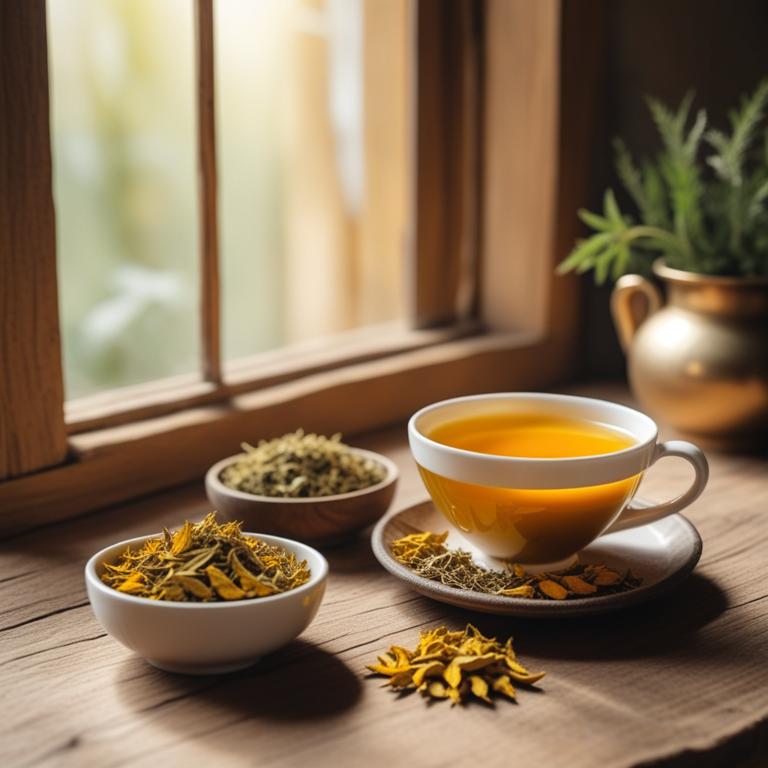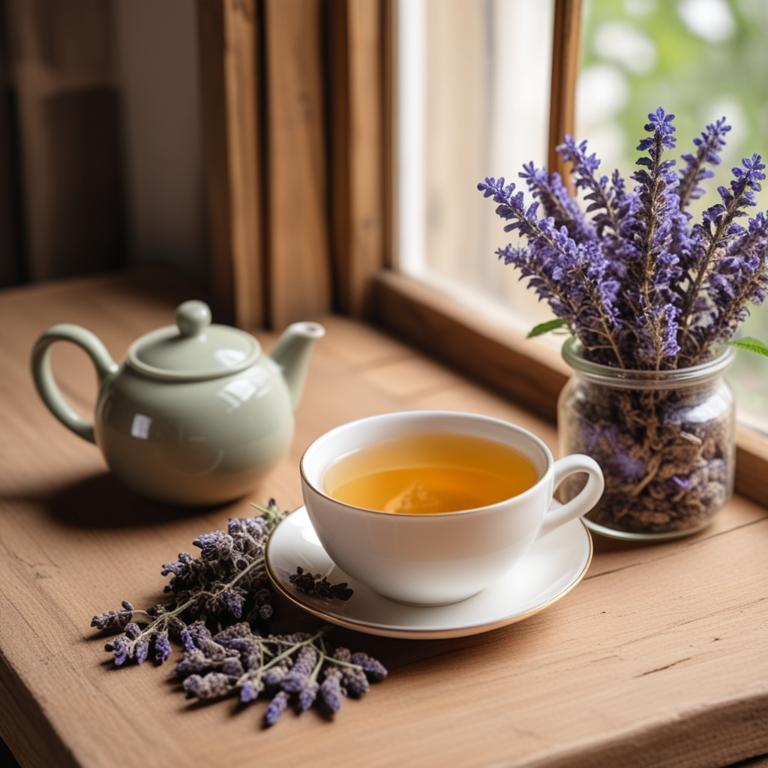7 Herbal Teas For Endometriosis Pain

Herbal teas can be a natural way to manage endometriosis pain.
Endometriosis is a condition where tissue similar to the lining of the uterus grows outside the uterus, causing pain, heavy bleeding, and other issues. Some herbal teas, like ginger (Zingiber officinale), licorice root (Glycyrrhiza glabra), and turmeric (Curcuma longa), have anti-inflammatory properties that can help reduce pain and inflammation. Ginger, for example, contains a compound called gingerol, which has been shown to reduce pain and inflammation by blocking the production of pain-causing chemicals in the body. Licorice root has anti-inflammatory properties that can help soothe the digestive system and reduce bloating, which is often a symptom of endometriosis.
Turmeric contains a powerful antioxidant called curcumin, which has been shown to reduce inflammation and pain by blocking the production of pro-inflammatory enzymes. Drinking these herbal teas can bring several benefits to your life. For one, they can help reduce the frequency and severity of endometriosis symptoms, making it easier to manage your daily life. They can also help reduce the need for pain medication, which can have side effects. Additionally, herbal teas are often calming and soothing, which can help reduce stress and anxiety, common companions to endometriosis.
Many people find that drinking herbal teas regularly can help them feel more balanced and in control, which is especially important when managing a chronic condition like endometriosis.
- 1. Zingiber officinale
- 2. Glycyrrhiza glabra
- 3. Curcuma longa
- 4. Lavandula angustifolia
- 5. Ginkgo biloba
- 6. Vitex agnus-castus
- 7. Rosmarinus officinalis
1. Zingiber officinale

Zingiber officinale teas contains compounds like gingerol and shogaol, which have anti-inflammatory properties.
These properties help reduce inflammation and swelling in the body, which can be a contributor to endometriosis pain. Ginger's antioxidant properties also help protect the body from oxidative stress, which can exacerbate endometriosis symptoms. Furthermore, ginger's ability to relax muscles and improve blood flow may help alleviate cramps and other discomfort associated with endometriosis.
By reducing inflammation and promoting relaxation, Zingiber officinale teas may provide relief from endometriosis pain.
- Gather 1 cup of fresh Zingiber officinale (Ginger) roots.
- Peel the ginger roots and chop them into small pieces.
- Heat 2 cups of water in a pot and bring it to a boil.
- Add 2-3 tablespoons of the chopped ginger to the boiling water and reduce the heat.
- Let the ginger tea simmer for 5-7 minutes, then strain and drink.
Zingiber Officinale Tea on Amazon
FGO Organic Ginger Tea, 100 Count, Eco-Conscious Tea Bags, Caffeine Free, Packaging May Vary (Pack of 1)
Disclaimer: We earn a commission if you click this link and make a purchase at no additional cost to you.
2. Glycyrrhiza glabra

Glycyrrhiza glabra teas contains active constituents like glycyrrhizin, flavonoids, and coumarins.
Glycyrrhizin has anti-inflammatory properties, which help reduce inflammation in the uterus, a common symptom of endometriosis. Flavonoids, particularly isorhapontigenin, have antioxidant and anti-proliferative effects, which may slow down the growth of endometrial cells and alleviate pain. Coumarins, like scopoletin, possess analgesic and anti-inflammatory properties, helping to ease cramps and discomfort associated with endometriosis.
By reducing inflammation and slowing down cell growth, these compounds in Glycyrrhiza glabra teas may help alleviate endometriosis pain.
- Gather 1 cup of dried Glycyrrhiza glabra roots. You can buy it from a health food store or online.
- Measure 1 tablespoon of dried roots and put it in a tea infuser or a small muslin bag.
- Heat 1 cup of water in a pot and bring it to a boil.
- Pour the boiling water over the tea infuser or muslin bag. Let it steep for 5-7 minutes.
- Strain the tea and drink it warm or cool. You can add honey to taste. Drink 2-3 cups a day for endometriosis pain relief.
3. Curcuma longa

Curcuma longa teas contains a group of compounds called curcuminoids, specifically curcumin, demethoxycurcumin, and bisdemethoxycurcumin.
These compounds have strong anti-inflammatory properties, which can reduce inflammation and swelling in the body. Curcumin, the main active constituent, blocks the production of prostaglandins, hormone-like substances that cause pain and inflammation. Additionally, curcuminoids have antioxidant properties, which help protect the body from damage caused by free radicals and promote healing.
By reducing inflammation and promoting healing, Curcuma longa teas may help alleviate the chronic pain and discomfort associated with endometriosis.
- Gather 1 tablespoon of dried Turmeric root powder and 1 cup of boiling water.
- Add the Turmeric powder to the boiling water and stir well.
- Reduce heat to low and let it simmer for 5-7 minutes.
- Strain the mixture into a cup and let it cool for a few minutes.
- Drink the Turmeric tea 2-3 times a day to help manage endometriosis pain.
4. Lavandula angustifolia

Lavandula angustifolia teas contains linalool and linalyl acetate, two bioactive constituents that have anti-inflammatory and pain-relieving properties.
These compounds work by blocking the production of prostaglandins, hormone-like substances that cause pain and inflammation. By reducing prostaglandin levels, Lavandula angustifolia teas can help alleviate the chronic pain associated with endometriosis. Additionally, the tea's antispasmodic properties can help relax the uterine muscles, reducing cramping and discomfort.
The anti-inflammatory and analgesic effects of Lavandula angustifolia teas make it a potential natural remedy for managing endometriosis pain.
- Gather 1 cup of dried Lavandula angustifolia flowers.
- Boil 1 cup of water in a pot.
- Add 1-2 teaspoons of dried flowers to the boiling water.
- Let the mixture steep for 5-7 minutes, then strain it.
- Drink 1 cup of the tea, 2-3 times a day, to help with endometriosis pain.
5. Ginkgo biloba

Ginkgo biloba teas contains active constituents like flavonoids and terpenoids, which help reduce inflammation and improve blood flow to the pelvic area.
The flavonoids, particularly quercetin and kaempferol, have potent antioxidant properties that combat oxidative stress, a known contributor to endometriosis pain. Terpenoids, such as bilobalide and ginkgolides, have anti-inflammatory effects that may help alleviate pain and discomfort associated with endometriosis. Ginkgo biloba's ability to thin the blood and improve circulation may also help reduce menstrual cramps and heavy bleeding, common symptoms of endometriosis.
By reducing inflammation and promoting healthy blood flow, Ginkgo biloba teas may provide relief from endometriosis-related pain and discomfort.
- Gather 1 cup of water and 1 tablespoon of dried Ginkgo biloba leaves in a saucepan.
- Bring the water to a boil, then reduce the heat to a simmer.
- Add the Ginkgo biloba leaves to the water and let it steep for 5-7 minutes.
- Strain the tea into a cup using a fine-mesh sieve or cheesecloth.
- Drink the tea 2-3 times a day to help manage endometriosis pain.
6. Vitex agnus-castus

Vitex agnus-castus teas contains iridoid glycosides, flavonoids, and phenolic acids.
These compounds have anti-inflammatory properties, which help reduce inflammation in the body and alleviate endometriosis pain. The iridoid glycoside agnuside has been shown to have a regulating effect on hormonal balance, particularly in the production of estrogen, which is often associated with endometriosis. The anti-inflammatory and antioxidant properties of Vitex agnus-castus tea may also help reduce oxidative stress and promote healing in the endometrial tissue.
By regulating hormonal balance and reducing inflammation, Vitex agnus-castus teas can help alleviate the symptoms of endometriosis.
- Gather 1 cup of fresh or dried Vitex agnus-castus leaves and flowers.
- Measure 1 tablespoon of the gathered leaves and flowers and place them in a heat-resistant cup.
- Boil 1 cup of water in a kettle or on the stovetop and carefully pour it over the Vitex agnus-castus leaves and flowers in the cup.
- Steep the mixture for 5-7 minutes, then strain the liquid using a fine-mesh sieve or cheesecloth into another cup.
- Drink the tea 2-3 times a day, ideally between meals, to help alleviate endometriosis pain.
7. Rosmarinus officinalis

Rosmarinus officinalis teas contains rosmarinic acid, carnosic acid, and ursolic acid, which are antioxidant and anti-inflammatory compounds.
These properties help reduce inflammation and oxidative stress in the body, which are common contributors to endometriosis pain. Rosmarinic acid has also been shown to inhibit the production of pro-inflammatory enzymes, reducing pain and discomfort. Carnosic acid has antioxidant properties that protect cells from damage, which can help alleviate symptoms associated with endometriosis.
By reducing inflammation and protecting cells, Rosmarinus officinalis teas may provide relief from endometriosis pain.
- Gather 1 cup of fresh or dried Rosmarinus officinalis leaves and flowers.
- Measure 250ml of boiling water and let it cool for 5 minutes.
- Add 2 tablespoons of Rosmarinus officinalis leaves and flowers to the cooled water.
- Steep for 5-7 minutes, then strain the tea into a cup.
- Drink the tea 2-3 times a day to help manage endometriosis pain.